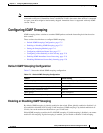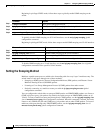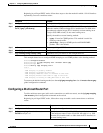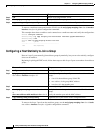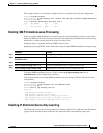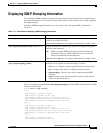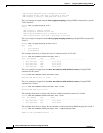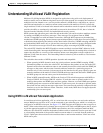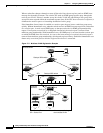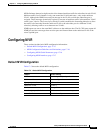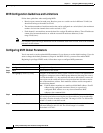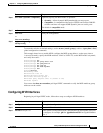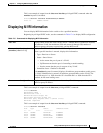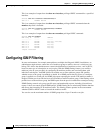
17-13
Catalyst 2950 Desktop Switch Software Configuration Guide
78-14982-01
Chapter 17 Configuring IGMP Snooping and MVR
Understanding Multicast VLAN Registration
Understanding Multicast VLAN Registration
Multicast VLAN Registration (MVR) is designed for applications using wide-scale deployment of
multicast traffic across an Ethernet ring-based service provider network (for example, the broadcast of
multiple television channels over a service-provider network). MVR allows a subscriber on a port to
subscribe and unsubscribe to a multicast stream on the network-wide multicast VLAN. It allows the
single multicast VLAN to be shared in the network while subscribers remain in separate VLANs. MVR
provides the ability to continuously send multicast streams in the multicast VLAN, but to isolate the
streams from the subscriber VLANs for bandwidth and security reasons.
MVR assumes that subscriber ports subscribe and unsubscribe (join and leave) these multicast streams
by sending out IGMP join and leave messages. These messages can originate from an IGMP
version-2-compatible host with an Ethernet connection. Although MVR operates on the underlying
mechanism of IGMP snooping, the two features operate independently of each other. One can be enabled
or disabled without affecting the behavior of the other feature. However, if IGMP snooping and MVR
are both enabled, MVR reacts only to join and leave messages from multicast groups configured under
MVR. Join and leave messages from all other multicast groups are managed by IGMP snooping.
The switch CPU identifies the MVR IP multicast streams and their associated MAC addresses in the
switch forwarding table, intercepts the IGMP messages, and modifies the forwarding table to include or
remove the subscriber as a receiver of the multicast stream, even though the receivers might be in a
different VLAN from the source. This forwarding behavior selectively allows traffic to cross between
different VLANs.
The switch has these modes of MVR operation: dynamic and compatible.
• When operating in MVR dynamic mode, the switch performs standard IGMP snooping. IGMP
information packets are sent to the switch CPU, but multicast data packets are not sent to the CPU.
Dynamic mode allows the multicast router to run normally because the switch sends the IGMP join
messages to the router, and the router forwards multicast streams for a particular group to an
interface only if it has received a join message from the interface for the group. Receiver ports are
treated as members of the multicast VLAN for MVR multicast control and data traffic. IGMP reports
for MVR groups are sent out source ports in the multicast VLAN.
• When in MVR compatible mode, MVR on the Catalyst 3550 switch interoperates with MVR on
Catalyst 3500 XL and Catalyst 2900 XL switches. It works the same as dynamic mode for all
multicast data packets and IGMP query and leave packets. However, received IGMP report packets
for MVR groups are not sent out on the multicast VLAN source ports. In contrast to dynamic mode,
the switch does not send join messages to the router. The router must be statically configured for the
interface to receive the multicast stream. Therefore, in this mode, MVR does not support dynamic
membership joins on source ports.
Using MVR in a Multicast Television Application
In a multicast television application, a PC or a television with a set-top box can receive the multicast
stream. Multiple set-top boxes or PCs can be connected to one subscriber port, which is a switch port
configured as an MVR receiver port. See Figure 17-3. DHCP assigns an IP address to the set-top box or
the PC. When a subscriber selects a channel, the set-top box or PC sends an IGMP report to the S1 switch
to join the appropriate multicast. If the IGMP report matches one of the configured multicast MAC
addresses, the switch CPU modifies the hardware address table to include this receiver port and VLAN
as a forwarding destination of the specified multicast stream when it is received from the multicast
VLAN. Uplink ports that send and receive multicast data to and from the multicast VLAN are called
MVR source ports.



